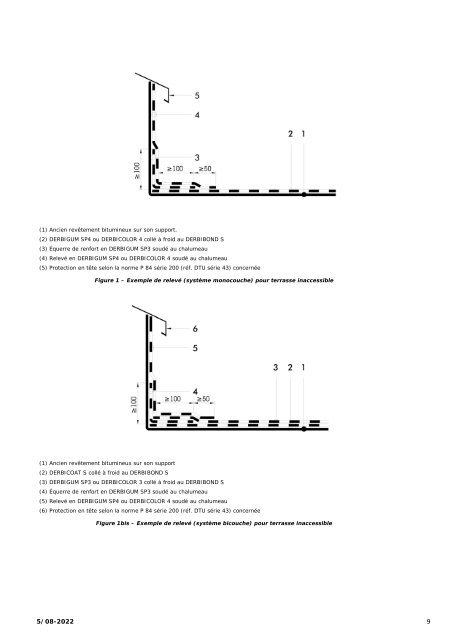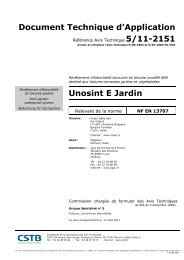Document Technique d'Application Derbigum collé à froid sur ...
Document Technique d'Application Derbigum collé à froid sur ...
Document Technique d'Application Derbigum collé à froid sur ...
You also want an ePaper? Increase the reach of your titles
YUMPU automatically turns print PDFs into web optimized ePapers that Google loves.
(1) Ancien revêtement bitumineux <strong>sur</strong> son support.<br />
(2) DERBIGUM SP4 ou DERBICOLOR 4 <strong>collé</strong> <strong>à</strong> <strong>froid</strong> au DERBIBOND S<br />
(3) Équerre de renfort en DERBIGUM SP3 soudé au chalumeau<br />
(4) Relevé en DERBIGUM SP4 ou DERBICOLOR 4 soudé au chalumeau<br />
(5) Protection en tête selon la norme P 84 série 200 (réf. DTU série 43) concernée<br />
Figure 1 – Exemple de relevé (système monocouche) pour terrasse inaccessible<br />
(1) Ancien revêtement bitumineux <strong>sur</strong> son support<br />
(2) DERBICOAT S <strong>collé</strong> <strong>à</strong> <strong>froid</strong> au DERBIBOND S<br />
(3) DERBIGUM SP3 ou DERBICOLOR 3 <strong>collé</strong> <strong>à</strong> <strong>froid</strong> au DERBIBOND S<br />
(4) Équerre de renfort en DERBIGUM SP3 soudé au chalumeau<br />
(5) Relevé en DERBIGUM SP4 ou DERBICOLOR 4 soudé au chalumeau<br />
(6) Protection en tête selon la norme P 84 série 200 (réf. DTU série 43) concernée<br />
Figure 1bis – Exemple de relevé (système bicouche) pour terrasse inaccessible<br />
5/08-2022 9



